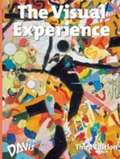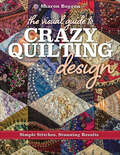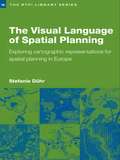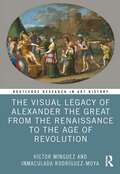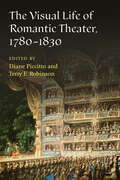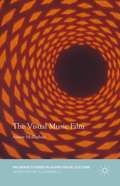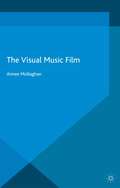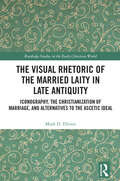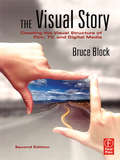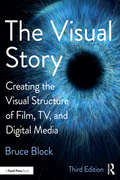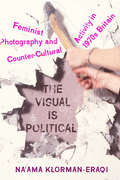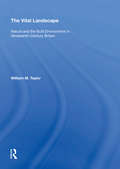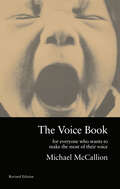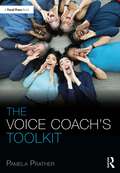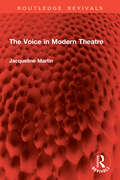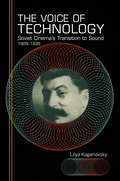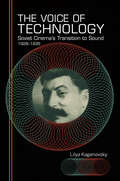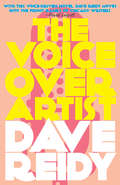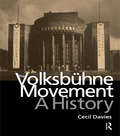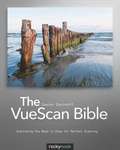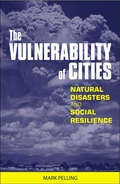- Table View
- List View
The Visual Experience
by Jack Hobbs Ken Vieth Richard SalomeLEVEL: Key Stage 4 onwards. A comprehensive art appreciation program, 'The Visual Experience' is a complete visual art curriculum that integrates art history, aesthetics, criticism, and production. The third edition has: All new studio experiences; More artists biographies; More contemporary art; Step-by-step art criticism in every major chapter; Writing emphasised throughout.
The Visual Experience
by Jack Hobbs Ken Vieth Richard SalomeLEVEL: Key Stage 4 onwards. A comprehensive art appreciation program, 'The Visual Experience' is a complete visual art curriculum that integrates art history, aesthetics, criticism, and production. The third edition has: All new studio experiences; More artists biographies; More contemporary art; Step-by-step art criticism in every major chapter; Writing emphasised throughout.
The Visual Experience (2nd Edition)
by Jack Hobbs Richard SalomeDesigned for students, this volume explores the expression and construction of art, and discusses the creative and technical processes of art. The book consists of different elements that will help you understand what art is, how it is made, and how it can make your life richer.
The Visual Guide to Crazy Quilting Design: Simple Stitches, Stunning Results
by Sharon BoggonSee it, stitch it! Thirty-five contemporary crazy-quilting stitches, photographed step by step. Rooted in the Victorian era, crazy quilting has a powerful allure for today's quilters, who use it to let loose and tell a unique story with fabric. Embrace crazy quilting with thirty-five must-know stitches and endless variations, shown in clear, step-by-step photographs for both right- and left-handed stitchers. Fine artist Sharon Boggon reveals design fundamentals to guide you in your process, so you can sew thoughtful, visually appealing blocks. Learn the theory and process behind this fascinating art: how to choose fabrics, piece stitch-and-flip blocks, and embellish seams with embroidery, beads, buttons, and charms. • Learn crazy-quilting techniques with colorful photos that show every detail • Combine fabric, embellishments, and thirty-five stitches, plus endless variations, into stunning crazy quilts as unique as you • Unpack savvy design principals to make order of the chaos and guide the viewer's eye around the block
The Visual Language of Spatial Planning: Exploring Cartographic Representations for Spatial Planning in Europe (RTPI Library Series)
by Stefanie DührAt a time when strategic spatial planning is undergoing a renaissance in Europe, The Visual Language of Spatial Planning makes a unique contribution to this rapidly growing area of teaching and research. Discussing the relevant theoretical perspectives on policy-making and planning, combined with cartographic communication and the use of cartographic representations in the planning process, Stephanie Duhr provides conceptual and practical tools to help students and practitioners better understand maps and visualizations in strategic spatial planning. The book is the first to review the form, style and use of cartographic representations in strategic spacial plans in the Netherlands, Germany and England as well as at European level. Significant differences between planning traditions and the impact of these on transnational planning processes are highlighted. It concludes by discussing the practical implications for future strategic spacial planning processes in Europe and the best use of cartographic representations to reach agreement and to focus dialogue.
The Visual Language of Technique
by Luigi CocchiarellaThe book is inspired by the third seminar in a cycle connected to the celebrations of the 150th anniversary of the Politecnico di Milano (July 2013). "Educating by Image. Teaching Styles vs Learning Styles" was the motto of this meeting. The contributions (coming from lectures, the poster session, interviews and round table) aim to propose an updated look at visual education, highlighting how digital tools and networks have profoundly affected the "representational styles" of the teachers and the "cognitive styles" of the learners, while at the same time reaffirming the importance of the interaction between the two groups. As Herbert Alexander Simon once said, "Learning results. . . only from what the student does and thinks"; therefore "the teacher can advance learning only by influencing what the student does to learn". That is no mean feat if we consider that, according to Benjamin Samuel Bloom, visual education not only involves the pure cognition, but also the affective and the psychomotor domains, not to mention the social aspects. This is why, alongside some theoretical and historical retrospectives, the contributions recommend a continuous revision of "what" and "how" could be included in the academic curricula, also in connection with secondary schools, the professional world, targeted Lifelong Learning Programmes for students and teachers. The volume includes an interview with the science journalist and writer Piero Angela.
The Visual Legacy of Alexander the Great from the Renaissance to the Age of Revolution (Routledge Research in Art History)
by Víctor Mínguez Inmaculada Rodríguez-MoyaThis is an analysis of the diverse facets of Alexander the Great’s image from the Renaissance era through the Baroque into the nineteenth century. Perceived as the first sovereign ruler of the world, for centuries Alexander became an exemplar for the most ambitious kings and emperors. This cultural phenomenon flourished above all in the Renaissance while extending into the nineteenth century. Early modern monarchs’ identification with Alexander associated them with ideas of kingly wisdom. Yet this admiration waned on occasions. Napoleon was Alexander of Macedonia’s most ardent critic. During the nineteenth century, the Macedonian hero was viewed as an individual who won control of the Achaemenid empire, but also underwent a progressive moral decline that converted him into a tyrant. The book will be of interest to scholars working in art history and iconography.
The Visual Life of Romantic Theater, 1780-1830
by Diane Piccitto Terry F. RobinsonThe Visual Life of Romantic Theater examines the dynamism and vibrancy of stage spectacle and its impact in an era of momentous social upheaval and aesthetic change. Situating theatrical production as key to understanding visuality ca. 1780-1830, this book places the stage front and center in Romantic scholarship by re-envisioning traditional approaches to artistic and social creation in the period. How, it asks, did dramaturgy and stagecraft influence aesthetic and sociopolitical concerns? How does a focus on visuality expand our understanding of the historical experience of theatergoing? In what ways did stage performance converge with visual culture beyond the theater? How did extratheatrical genres engage with theatrical sight and spectacle? Finally, how does a focus on dramatic vision change the way we conceive of Romanticism itself? The volume’s essays by emerging and established scholars provide exciting and suggestive answers to these questions, along with a more capacious conception of Romantic theater as a locus of visual culture that reached well beyond playhouse walls.
The Visual Music Film (Palgrave Studies in Audio-Visual Culture)
by Aimee MollaghanAdopting an interdisciplinary approach, The Visual Music Film explores the concept and expression of musicality in the visual music film, in which visual presentations are given musical attributes such as rhythmical form, structure and harmony.
The Visual Music Film (Palgrave Studies in Audio-Visual Culture)
by Aimee MollaghanAdopting an interdisciplinary approach, The Visual Music Film explores the concept and expression of musicality in the visual music film, in which visual presentations are given musical attributes such as rhythmical form, structure and harmony.
The Visual Rhetoric of the Married Laity in Late Antiquity: Iconography, the Christianization of Marriage, and Alternatives to the Ascetic Ideal (Routledge Studies in the Early Christian World)
by Mark D. EllisonThis study examines third- and fourth-century portraits of married Christians and associated images, reading them as visual rhetoric in early Christian conversations about marriage and celibacy, and recovering lay perspectives underrepresented or missing in literary sources. Historians of early Christianity have grown increasingly aware that written sources display an enthusiasm for asceticism and sexual renunciation that was far from representative of the lives of most early Christians. Often called a “silent majority,” the married laity in fact left behind a significant body of work in the material record. Particularly in and around Rome, they commissioned and used such objects as sarcophagi, paintings, glass vessels, finger rings, luxury silver, other jewellery items, gems, and seals that bore their portraits and other iconographic forms of self-representation. This study is the first to undertake a sustained exploration of these material sources in the context of early Christian discourses and practices related to marriage, sexuality, and celibacy. Reading this visual evidence increases understanding of the population who created it, the religious commitments they asserted, and the comparatively moderate forms of piety they set forth as meritorious alternatives to the ascetic ideal. In their visual rhetoric, these artifacts and images comprise additional voices in Late Antique conversations about idealized ways of Christian life, and ultimately provide a fuller picture of the early Christian world. Plentifully illustrated with photographs and drawings, this volume provides readers access to primary material evidence. Such evidence, like textual sources, require critical interpretation; this study sets forth a careful methodology for iconographic analysis and applies it to identify the potential intentions of patrons and artists and the perceptions of viewers. It compares iconography to literary sources and ritual practices as part of the interpretive process, clarifying the ways images had a rhetorical edge and contributed to larger conversations. Accessibly written, The Visual Rhetoric of the Married Laity in Late Antiquity is of interest to students and scholars working on Late Antiquity, early Christian and late Roman social history, marriage and celibacy in early Christianity, and early Christian, Roman, and Byzantine art.
The Visual Story: Creating the Visual Structure of Film, TV and Digital Media
by Bruce BlockIf you can't make it to one of Bruce Block's legendary visual storytelling seminars, then you need his book! Now in full color for the first time, this best-seller offers a clear view of the relationship between the story/script structure and the visual structure of a film, video, animated piece, or video game. You'll learn how to structure your visuals as carefully as a writer structures a story or a composer structures music. Understanding visual structure allows you to communicate moods and emotions, and most importantly, reveals the critical relationship between story structure and visual structure.The concepts in this book will benefit writers, directors, photographers, production designers, art directors, and editors who are always confronted by the same visual problems that have faced every picture maker in the past, present, and future.
The Visual Story: Creating the Visual Structure of Film, TV, and Digital Media
by Bruce BlockThis updated edition of a best-selling classic shows you how to structure your visuals as carefully as a writer structures a story or composers structure their music. The Visual Story teaches you how to design and control the structure of your production using the basic visual components of space, line, shape, tone, color, movement, and rhythm. You can use these components to effectively convey moods and emotions, create a visual style, and utilize the important relationship between the visual and the story structures. Using over 700 color illustrations, author Bruce Block explains how understanding the connection between story and visual structures will guide you in the selection of camera angles, lenses, actor staging, composition, set design and locations, lighting, storyboard planning, camera coverage, and editing. The Visual Story is an ideal blend of theory and practice. The concepts and examples in this new edition will benefit students learning cinematic production, as well as professional writers, directors, cinematographers, art directors, animators, game designers, and anyone working in visual media who wants a better understanding of visual structure.
The Visual is Political: Feminist Photography and Countercultural Activity in 1970s Britain
by Na'Ama Klorman-EraqiThe Visual is Political examines the growth of feminist photography as it unfolded in Britain during the 1970s and 1980s. This period in Britain was marked by instability following the collapse of the welfare state, massive unemployment, race riots, and workers’ strikes. However, this was also a time in which various forms of social activism emerged or solidified, including the Women’s Movement, whose members increasingly turned to photography as a tool for their political activism. Rather than focusing on the aesthetic quality of the images produced, Klorman-Eraqi looks at the application of feminist theory, photojournalism, advertising, photo montage, punk subculture and aesthetics, and politicized street activity to emphasize the statement and challenge that the photographic language of these works posed. She shows both the utilitarian uses of photography in activism, but also how these same photographers went on to be accepted (or co-opted) into the mainstream art spaces little by little, sometimes with great controversy. The Visual is Political highlights the relevance and impact of an earlier contentious, creative, and politicized moment of feminism and photography as art and activism.
The Vital Landscape: Nature and the Built Environment in Nineteenth-Century Britain
by William M. TaylorThe Vital Landscape explores the arrival of the biological sciences - most notably the sciences oflife entailed in studies of botany and zoology, ecology and evolutionary science, physiology and psychology - in the nineteenth century and their impact on architecture and landscape architecture in Great Britain. Specifically, the book explores the idea of the contrived or artificial environment as an object of both scientific speculation and aesthetic reflection. Unlike specialist histories of biological science or environmental thought, this book is unique in locating one source for present-day concerns for the environment and human well-being in debates over proper housing and the growing popularity of domestic and public gardens in the nineteenth century. The book skilfully interweaves architecture and garden history, the history and philosophy of science, plant and animal physiology and human psychology, works of literature, popular science and domestic economy in a story that opens new opportunities for the study of architecture and gardens.
The Voice Book: Revised Edition
by Michael McCallionA practical manual for voice users of all kinds, The Voice Book is written by one of the world's leading voice teachers. Michael McCallion has spent over 35 years training various professionals, from performers to auctioneers, how to use their voice. Used throughout the world in actor training and as suggested reading for lawyers, the earlier edition of The Voice Book became the classic work on using one's voice. It has now been revised to make use of the feedback from numerous readers of the earlier edition. Clearly written and easy to use, McCallion covers everything from Body Use and Breathing, to Tuning and Voice Energy. Whether you are a professional or amateur actor, a classical or popular singer, a teacher, or need to present for business, The Voice Book will help you discover how to use your voice freely, powerfully and with pleasure.
The Voice Coach's Toolkit (The Focal Press Toolkit Series)
by Pamela PratherThe Voice Coach's Toolkit identifies the primary professional vocal coaching opportunities and the avenues by which a student or early career coach can navigate the vocation. For purposes of this book, the Voice Coach is defined as someone who coaches the spoken voice in three precise areas: the teaching artist, the professional film/TV/theatre coach, and the professional voice-user coach. These three coaching worlds are broadly defined and each area includes in-depth interviews and practical advice from top coaches along with the author’s personal expertise. The book can be read in sections or as a whole, making it as useful for early career coaches as it is for those looking to expand their vocal coaching career or vocal pedagogy students who need a broad survey of all three areas.
The Voice in Modern Theatre (Routledge Revivals)
by Jacqueline MartinFirst published in 1991, The Voice in Modern Theatre places voice and speech practice in the theatre in historical and theoretical perspective. It traces the development of vocal delivery from its roots in Greek rhetoric, and explains the wide range of approaches to the voice in the modern day theatre. Taking an international perspective, Jacqueline Martin assesses the influence of key theorists, with their often conflicting ideologies and of specific directors. By focusing on Shakespeare, the whole question of contemporary interpretation of the classics and the treatment of verse is addressed. A final chapter on actor training compares a number of British training institutions with their European counterparts.This book will interest teachers of voice and speech in training institutions and universities, directors and actors and teachers and students of modern theatre.
The Voice of Newfoundland
by Jeff WebbSimilar to the CBC and BBC, the Broadcasting Corporation of Newfoundland was a public broadcaster that was at the centre of a cultural and political change from 1939 to 1949, during which Newfoundland faced wartime challenges and engaged in a constitutional debate about whether to become integrated into Canada. The Voice of Newfoundland studies these changes by taking a close look at the Broadcasting Corporation of Newfoundland's radio programming and the responses of their listeners. Making excellent use of program recordings, scripts, and letters from listeners, as well as government and corporate archives, Jeff A. Webb examines several innovative programs that responded to the challenges of the Great Depression and Second World War. Webb explores the roles that radio played in society and culture during a vibrant and pivotal time in Newfoundland's history, and demonstrates how the broadcaster's decision to air political debates was pivotal in Newfoundlanders's decision to join Canada and to become part of North American consumer society. An engaging study rich in details of some of twentieth-century Newfoundland's most fascinating figures, The Voice of Newfoundland is a remarkable history of its politics and culture and an important analysis of the influence of the media and the participation of listeners.
The Voice of Technology: Soviet Cinema's Transition to Sound, 1928–1935
by Lilya KaganovskyAs cinema industries around the globe adjusted to the introduction of synch-sound technology, the Soviet Union was also shifting culturally, politically, and ideologically from the heterogeneous film industry of the 1920s to the centralized industry of the 1930s, and from the avant-garde to Socialist Realism. In The Voice of Technology: Soviet Cinema’s Transition to Sound, 1928–1935, Lilya Kaganovsky explores the history, practice, technology, ideology, aesthetics, and politics of the transition to sound within the context of larger issues in Soviet media history. Industrialization and centralization of the cinema industry greatly altered the way movies in the Soviet Union were made, while the introduction of sound radically influenced the way these movies were received. Kaganovsky argues that the coming of sound changed the Soviet cinema industry by making audible, for the first time, the voice of State power, directly addressing the Soviet viewer. By exploring numerous examples of films from this transitional period, Kaganovsky demonstrates the importance of the new technology of sound in producing and imposing the "Soviet Voice."
The Voice of Technology: Soviet Cinema's Transition to Sound, 1928–1935
by Lilya KaganovskyA deeply researched exploration of the technology, aesthetics, and politics of Soviet film during the transition from silent to sound. As cinema industries around the globe adjusted to the introduction of synch-sound technology, the Soviet Union was also shifting culturally, politically, and ideologically from the heterogeneous film industry of the 1920s to the centralized industry of the 1930s, and from the avant-garde to Socialist Realism. In The Voice of Technology: Soviet Cinema&’s Transition to Sound, 1928–1935, Lilya Kaganovsky explores the history, practice, technology, ideology, aesthetics, and politics of the transition to sound within the context of larger issues in Soviet media history. Industrialization and centralization of the cinema industry greatly altered the way movies in the Soviet Union were made, while the introduction of sound radically altered the way these movies were received. Kaganovsky argues that the coming of sound changed the Soviet cinema industry by making audible, for the first time, the voice of State power, directly addressing the Soviet viewer. By exploring numerous examples of films from this transitional period, Kaganovsky demonstrates the importance of the new technology of sound in producing and imposing the &“Soviet Voice.&” &“Kaganovsky&’s research is impeccable. Not only does she reference virtually all English-language writing on her subject, she also has combed the archives, unearthing personal stories, government records, filmmakers&’ notes, press reviews from the period, and other previously untranslated documents.&” —CineMontage
The Voiceover Artist
by Dave ReidySimon Davies suffers a crippling stutter inherited from his father. At the age of seven, he decides to stop speaking completely-eventually rendering his vocal cords useless from atrophy. <P><P>Unable to speak, Simon finds solace in the voices piping through his bedside radio.Eighteen years later, Simon rebuilds his voice and learns to mostly manage his stutter with a series of subtle tics he's developed to loosen his vocal cords. He moves to Chicago and pursues his lifelong dream of becoming a voice on the radio-a voiceover artist. Meanwhile, his younger brother Connor, in every way more confident and charming than Simon, attempts to take his prodigious talent for improv comedy from the barroom stages of Chicago to the television studios of 30 Rockefeller Plaza in New York City. Coming out of his years of silence, Simon seeks to balance his relationship with his brother, forcing Connor to examine what brotherhood and success mean to him.Told in a series of first-person narratives by the characters who weave in and out of Simon's life, The Voiceover Artist considers the complexities of family and celebrates the heart with which we fight to fulfill our dreams.
The Volksbuhne Movement: A History
by Cecil DaviesThis publication is the first comprehensive account in English of the history of the Freie Volksb^D"hne, founded in Berlin in 1890 through the interaction of Social Democracy and Theatrical Naturalism. Cecil Davies details the nationwide growth of the Volksb^D"hne Movement during the 1920s through the 1990s - including Germany's stormy history up to World War I, the problems associated with building the Volksbühne's own theatre, and the reunification of Germany. Weight is given to the contributions of major figures in the movement such as Bruno Wille, Siegfried Nestriepke, and Erwin Piscator.
The VueScan Bible
by Sascha SteinhoffVueScan is the world's most widely used software interface for digitizing film and prints on flatbed and film scanners. This powerful yet affordable program supports over 1500 scanners and 321 digital camera RAW file types, and is available for Mac OS X, Windows, and Linux. Much more than a simple scanner program, VueScan allows you to perform functions such as color restoration, adding sharpening filters, adjusting white balance, rotating images, and batch scanning multiple images. It also provides output to a variety of formats including TIFF, JPEG, and searchable PDF files (even all three simultaneously). The Pro version outputs to the RAW format and provides options for color adjustments, and more. Despite its popularity, the documentation for VueScan does not provide enough information to use the full power of the system and makes it difficult to get started. The VueScan Bible is the missing manual for new, experienced, and prospective users of VueScan.
The Vulnerability of Cities: Natural Disasters and Social Resilience
by Mark PellingWhen disaster strikes in cities the effects can be catastrophic compared to other environments. But what factors actually determine the vulnerability or resilience of cities? The Vulnerability of Cities fills a vital gap in disaster studies by examining the too-often overlooked impact of disasters on cities, the conditions leading to high losses from urban disasters and why some households and communities withstand disaster more effectively than others. Mark Pelling takes a fresh look at the literature on disasters and urbanization in light of recent catastrophes. He presents three detailed studies of cities in the global South, drawn from countries with contrasting political and developmental contexts: Bridgetown, Barbados - a liberal democracy; Georgetown, Guyana - a post socialist-state; and Santo Domingo, Dominican Republic - an authoritarian state in democratic transition. This book demonstrates that strengthening local capacity - through appropriate housing, disaster-preparedness, infrastructure and livelihoods - is crucial to improving civic resilience to disasters. Equally important are strong partnerships between local community-based organizations, external non-governmental and governmental organizations, public and private sectors and between city and national government. The author highlights and discusses these best practices for handling urban disasters. With rapid urbanization across the globe, this book is a must-read for professionals, policy-makers, students and researchers in disaster management, urban development and planning, transport planning, architecture, social studies and earth sciences.
